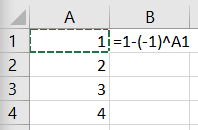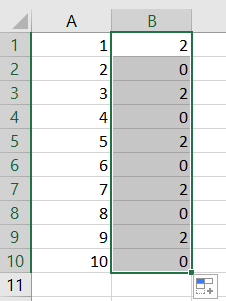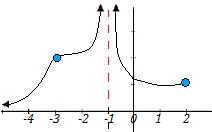
Generally speaking, a limit puts some kind of boundary in place: a point where you can’t (or shouldn’t) go any further. For example, a maximum speed limit of 75 m.p.h. creates an artificial boundary that you aren’t supposed to cross. In calculus, the limit of functions is still a kind of maximum (or minimum), but they are formalized more stringently.
More specifically, the limit of functions refers to the output (i.e. y-value) that a given function intends to reach as “x” moves towards some value. It answers the question “Which number did this function get to?” as well as “Which number did this function try to get to?”.
In real life, driving “at the speed limit” might mean you’re going at exactly 70 mph. But it can also mean 69.998, 69.999 mph. If you get very, very close, you can still say you drove at the speed limit; It’s the same thing in calculus: you’re looking for that intended value (e.g. 70 mph), even if you don’t quite get there.
Limit of Functions: Contents (Click to go to that article):
Definitions and Properties
- What is a Limit?
- One Sided Limits
- Limit of Functions from Below
- Limit of Functions from Above
- When Does the Limit Not Exist?
- What are Indeterminate Limits?
- Limit Inferior and Limit Superior
- Properties of Limits
- Slope of a Tangent Line using the Definition of a Limit
Finding Limit of Functions: Techniques
- Conjugate Method
- Dividing Out Technique Limits
- Direct Substitution.
- Factoring limits Examples
- Find Limits Using The Formal Definition of a Limit of Functions
- Find Limits Graphically
- Find Limits Numerically
- L’Hospital’s rule
- Special Limit Theorems: Definition, Examples
- Squeeze Theorem
Find Limit of Functions for Specific Situations:
- Polynomial Functions
- Linear Functions
- How to Find the Limit of a Secant Function
- Limit of Sum & Difference
- Finding Limits of Upper and Lower Sums
- Limits at infinity
- Limit of Product/Quotient
- Find the Limit of a Sequence
- Subsequential Limit.
Technology
What is a Limit?
A limit is a number that a function approaches.
For example, take the function f(x) = x + 4. If you evaluate the function at x = 5, the function equals:
f(5) = 5 + 4 = 9.
That number, 9, is the limit for this function at x = 5.
If you take a look at the graph of f(x) = x + 4, you’ll see that all of the numbers surrounding x = 5 (for example, 4.9, 4.999 or 5.1) all get close to (i.e. approach) the limit of 9.
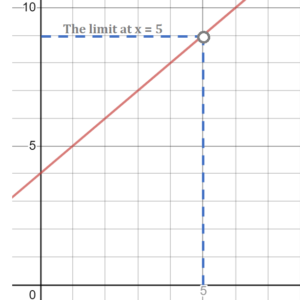
Another way of thinking of it, is that the output (y-value) function tops out at that particular value around that point (x = 5).
Notation
Limit notation is just used as shorthand. Instead of saying
“the limit at x = 5 approaches 9 for the function f(x) = x + 4”,
you would write:

Where the arrow just means “approaches.”
The general way of writing the notation, without reference to any specific function, is:

What the formula is basically telling you is that you plug in some number “a” into the function, and you get out some number L, the limit of the function.
You might also see the notation written like this:

This doesn’t mean that the limit is infinity. It means that you’re plugging in larger and larger x-values (i.e. x-values that are getting closer and closer to infinity) to see what happens.
Limits answer the question “Which number did this function get to?” as well as “Which number did this function try to get to?”. In other words, a function might try to get to a certain point, but it doesn’t actually get there. This makes is very useful for working with functions that have holes or gaps, like this one:

One Sided Limits

Why would we want to calculate the limit for one side only instead of from both sides? Because for some points it isn’t possible to find intervals on both sides of the point. For example, at endpoints (the point where the function ends), we can only approach the point from one side. You can use the information that is provided on that point to define both left-hand and/or right-hand limits.
Notation
A limit from the right is represented as follows:
![]()
The above formula tells us to calculate the limit of f(x) as x approaches a from the right (denoted by the arrow). The values will be greater than a.
A limit from the left is almost identical, except a+ becomes a-.
![]()
The values will be less than a.
When working with one-sided limits you will often be given a formula similar to the above and be asked to evaluate. Let’s take a look at an example.
Example: Evaluating a One Sided Limit
Evaluate
lim √x
x → 1+
Since 1 is positive, x is approaching 1 from the right. Putting the stated x-value (1) into the √(x) formula, you get:
√(1) = 1
So, the limit as you approach from the left is 1. For this simple equation, you could stop there and assume that the limit from the right is going to equal the same thing. But, there are sometimes surprised with functions, so always evaluate both sides of the limit—just in case.
Evaluate
lim √x
x → 1-
Here, 1 is negative and x is approaching 1 from the left. In other words, x will increase in value as it approaches x. Plugging x = 1 into the formula, we get the exact same thing (which is what you would expect).
Let’s take a look at a function that behaves a little differently.
Example 2
Example question: Evaluate the following one sided limit:
![]()
Unlike the first function, this one comes with a problem. If you don’t recognize it straight away, look at the graph:
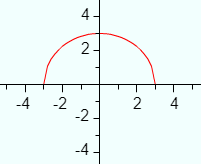
Coming from the right, the function doesn’t exist. And therefore, the limit would not exist.
However, you can evaluate a limit from the left with direct substitution:
![]()
So the solution is just as we’d expect from the graph: the limit is 0 as x approaches 3 from the left.
Limit of Functions: Limit from Below

Limit from Below, also known as a limit from the left, is a number that the “x” values approach as you move from left to right on the number line. The possible values of x approach a chosen value (e.g. x = 4) but never actually reach that value (e.g. 3.9, 3.99, 3.9999…).
In general terms, the limit from below restricts the variable x to a value less than the number the variable approaches. Again, these potential values of variable x are a limitless sequence of rational numbers.
A Simple Example
As an example, let’s take the variable x as it approaches the value 3 from below (or from the left):
x → 3
The x-values will be a sequence of numbers with values less than 3.
2.9, 2.99, 2.999, 2.9999, 2.99999….
While the variable x will get increasingly close to the value of 3, x will never equal the number selected as the point for the limit.
Example of Limit from Below
f(x) = x2 as x → 3 from below.
Step 1: Choose a series of x-values that are very close to the stated x-value, coming from the left of the number line. For this example, I’ll use the sequence values for x from above:
2.9, 2.99, 2.999, 2.9999, 2.99999
Step 2: Enter your x-values into the given function. The given function is x2, so the sequence x will become:
- 2.92 = 8.41
- 2.992 = 8.9401
- 2.9992 = 8.994001
- 2.99992 = 8.99940001
- 2.999992 = 8.9999400001
At the point x = 3 (coming from the left on the number line), x2 approaches 9.
Subsequential Limits
A subsequential limit is the limit of a subsequence; a subsequence is a smaller part of some larger sequence. For example, the integer sequence {1, 2, 1, 2} has two subsequences: one for odd numbers and one for even numbers.
Sometimes a limit doesn’t exist for a sequence, but does exist for one or more subsequences. For example, the limit for the following sequence doesn’t exist:

However, there are three subsequences with limits [1]:
- (x1, x4, x7, …) converges to 1.
- (x2, 51, 81, …) converges to 0.
- (x3, x6, x9, …) converges to -1.
Examples: Finding a Subsequential Limit
Example question #1: Find the subsequential limits of the sequence an = 1 – (-1)n.
The key here is to look for a pattern by generating some terms.
Step 1: Generate some terms of the sequence. One of the easiest ways to do this is in Excel. Here’s the steps:
- Type the numbers 1 through 10 in column A of a worksheet.
- Type the formula in cell B2. When you get to the “n”, click on cell A1.

- Press Enter, then grab the little square at the right hand corner of B2. Drag this square to the bottom of column B2.

- The limit inferior is the smallest limit of a subsequence.
- The limit superior is the largest limit of a subsequence.
- 0 < |x – 3| < δ
- |(2x + 4)-10| < ε
- |(2x + 4) – 10| < ε
- 0 < |x – 3|< δ =
- 0 < |x – 3|< ε/ 2 = (using the value for delta you derived in Step 2)
- 0 < 2|x – 3|< ε=
- 0 < |2x – 6| < ε=
- 0 <|2x + 4|- 10 < ε
- Both green arrows must point to the same number and
- Both arrows must be on the function’s line.
- The left-hand arrow is approaching y = -1, so we can say that the limit from the left (lim →-) is f(x) = -1.
- The right hand arrow is pointing to y = 2, so the limit from the right (lim →+) also exists and is f(x) = 2.
- As you decrease the increments, you’ll also want to change the place where your table starts (move the table to start at a place close to the x-value you are looking at). Otherwise, you’ll find yourself paging through hundreds of table values.
- If you want to check values very close to a number, you can also ask for individual table entries instead of the calculator returning a long list of incremental values. From the table options screen, arrow down to “Independent” and change the input from “Auto” to “Ask.” View the table, press ENTER and then enter an x-value (like -0.000000001).
Step 2: Identify the pattern. We have two subsequences here: odd numbers where the limit is 2 and even numbers where the limit is 0. Therefore, the subsequential limits are 0 and 2.
Example question #2: Find the subsequential limits of the sequence an = 1 – (-1)n.
Step 1: Generate some terms of the sequence. For this example, I didn’t see a pattern for the first ten terms, so I went much larger:
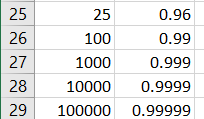
Step 2: Identify the pattern.The sequence (and all of its subsequences) converge to 1. This is an example where it may be easier to demonstrate the limit with algebra. We know that |an| = 1/n → -, so an → 1.
The limits of subsequences can more formally be defined by the limit inferior and limit superior.
Limit Inferior & Limit Superior
The limit inferior and limit superior of a sequence give bounds on the sequence’s subsequential limits (i.e. the limit of a subsequence) [1]:
For bounded sequences, these limits always exist [2].
In notation, the limit inferior may be written as:
![]()
The limit superior may be written as:
![]()
Visual Example of Limit Inferior and Limit Superior
The bounded sequence ai = (-1)i(i + 1)/i is not convergent.
However, two subsequences (odd terms and even terms) are convergent, as shown on the following graph:

From the graph, we can see that the subsequence of even terms converges to 1, which means that the limit superior = 1. The limit inferior converges from below to -1. These limits give a qualitative measure of a sequence’s asymptotic behavior [3].
Another example is the (relatively) famous divergent sequence (1, -1, 1, -1, 1,…). While the sequence as a whole does not converge, the even terms converge to -1 (i.e. lim inf = 1) and the odd terms converge to 1 (lim sup = 1).

Formal Definition
The limit inferior for a sequence xncan more formally be defined as follows:

The limit superior can be defined in a similar way:

The limit inferior is always smaller than the limit superior, unless the sequence is convergent. If that happens, then the two limits are equal. In notation, we can say:
lim inf ≤ lim sup.
Limit Inferior & Superior: References
Sequence Images: Desmos.
[1] Basic properties of limit inferior and limit superior. Retrieved May 3, 2021 from: https://www.uio.no/studier/emner/matnat/math/MAT1100/h20/grublelimsup.pdf
[2] Lebl, J. Basic Analysis I & II: Introduction to Real Analysis, Volumes I & II. 2.3 Limit superior, limit inferior, and Bolzano–Weierstrass. Retrieved May 3, 2021 from: https://www.jirka.org/ra/html/sec_bw.html
[3] Chidume Chapter 5. Retrieved May 3, 2021 from: http://www.math.utoledo.edu/~dwhite1/d_makerere/Chidume2.pdf
[4] Upper and Lower Limits of Sequences of Real Numbers. https://faculty.math.illinois.edu/~r-ash/RV/RV3.pdf
Solve Limits Step by Step Using The Formal Definition of a Limit
![]()
This section shows you how to solve limits using the formal limit definition.
The formal definition of a limit is:
“For any ε > 0, there is a δ > 0 so that |f(x) – L| < ε when 0 < |x-a| < δ”.
What it means is that when x gets close to a number, f(x) gets close to L, a limit. If you want to find limits, it’s more intuitive to solve limits numerically or solve limits graphically. However, it is possible to solve limits step by step using the formal definition.
Solve Limits Step by Step Example
Example question: Prove that the limit of f(x) = 2x + 4 is 10 as x approaches 3.
Step 1: Assign δ and ε to your x-value and your function, setting them up as inequalities:
Step 2: Find a value for δ (in this example, δ is |x-3|) in terms of ε. Start with the ε portion from step 1:
|(2x + 4) – 10| < ε =
|(2x-6| < ε = (Simplifying)
2|x-3| < ε =
|x-3|< ε/2 =
δ < ε/2
Step 3: Turn the inequality into an equals sign:
δ = ε/2
Step 4: Use algebra to manipulate the δ from Step 1. This time, your goal is to go from 0 < |x – 3|< δ): to
Tip: Step 2 is really all guesswork. Look for ways to make the numbers in the ε portion of the equation equal the δ numbers. In this example, there is a “3” in δ, so we simplified to 2x – 6 because 6 / 2 = 3. In Step 4, the sequence is essentially reversed to prove the formula works.
Finding Limit of Functions Graphically
You can’t get an exact figure for a limit from a graph, but you can get a very good approximation. When determining limits from a graph, look for y-values (called function values) near the x-value in the question.
Determining Limits From a Graph: Examples
The following examples are based on this graph of a piecewise function which has a jump at x = 1:

Example question 1: What is the limit of f(x) as x approaches 2?
Solution: “f(x)” is the function value at 2 (a.k.a. the y-value). We want to know what’s happening to the y-values around x = 2. Sketch a couple of arrows going to x = 2 from both sides and the answer should be clear:
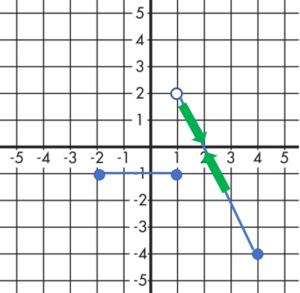
The green arrows show that as we approach x = 2 from both ends of the function, the y-value gets closer and closer to zero. Our answer: f(x) = 0.
Note: We never say “exactly” at 2, because we can’t be sure from a rudimentary graph like this that there’s not anything strange happening, like a pinprick hole. You can usually only find strange behavior like this algebraically, not graphically.
Example question 2: What is the limit of f(x) as x approaches 4?
Solution:This time, we have a problem, which becomes clear once we draw our green arrows:

The top arrow is pointing towards a y-value of 4. But the bottom arrow isn’t even on the line of the function…it’s sitting somewhere out in space. In order to determine a limit from a graph:
Both arrows are not on the function’s line, so the limit does not exist.
Example question 3: What is the limit as x approaches 1?
Solution:

Both arrows are not pointing to the same number, so the limit does not exist.
However, there are a couple of special limits that are denoted with a plus or minus sign (lim+ or lim-):
On the TI-89
It’s almost impossible to find the limit a functions without using a graphing calculator, because limits aren’t always apparent until you get very, very close to the x-value.
The TI-89 is one of the best calculators for calculus; if you have another brand (like an HP), the steps will still be the same, but you’ll have to refer to your calculator’s user guide for the specific key strokes.
Example problem: Find the limit for the function 3x2 – 3 / x2 – 9 as x approaches 0
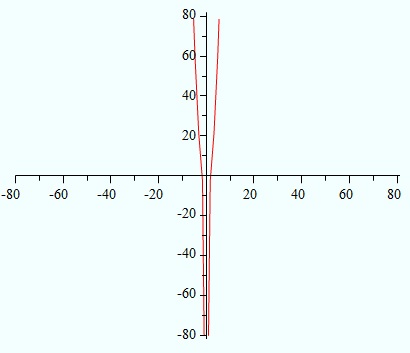
Step 1: Enter the function into the y1 slot of the “Y=” window. To open the window, press the Diamond key, then press the F1 key. Type the equation in and then press enter.
Step 2: Press the Diamond key, then F2 to enter the Window screen. This screen allows you to tell the calculator what view you want of the graph.
Step 3: Type a value into the xmin, xmax, ymin and ymax areas. For many functions, this will be guesswork until you can determine the behavior of the graph. For this particular example, type -5 for xmin, 5 for xmax, -1000 for ymin and 1000 for ymax (we are choosing a small window for the x-values because we want to see the limit around x = 0).
Step 4: Press the Diamond key and then F3 to graph the function.
Step 5: Press F3 for Trace.
Step 6: Press 0 and then press ENTER to see the y-value for x = 0. In this case, it will return nothing—x is undefined at this point.
Step 7: Repeat step 6, entering smaller increments close to x, like .001, .0001 and .00001. You should see the function values in this particular case approaching infinity.
Tip: Typically, your xmin and xmax are very small and your ymin and ymax are very large. If you are having trouble viewing the graph, construct a table of values so that you have a better idea of the graph’s behavior.
Back to Top
How to Find the Limit of a Function Numerically
The limit of a function is a particular value of x that the function approaches. You can find the limit of a function by graphing it—then the limit usually becomes obvious. But what if you have a function whose graph doesn’t help you? That sometimes happens when the limit is undefined at one particular point (you won’t be able to see it at all on a graph—it will appear to be a continuous function) or if the graph keeps on going towards infinity (“infinity” isn’t an x-value you can graph!). To find the limit for these functions, you’ll want to find the limit of functions numerically, using a table of values. You could make a table of values by hand. However, for most of the functions you’ll be dealing with in calculus, making a table of values by hand is impractical. The solution is to use your TI-89 graphing calculator.
Example question. What is the limit of 3x2 – 3 / x2 – 9 as x approaches 0?
Step 1: Enter the function into the y1 slot of the “Y=” window. To open the window, press the diamond key, then press the F1 key. Type the equation in and then press enter.
Step 2: Set the table options. To set the table options, press the diamond key and then press F4 . Change the settings for the given limit. For this example, set the table to start at -1 (just before the limit) and set the increments (Δ) to 1.
Step 3: Open the table: press the diamond and then press F5. Note that the table states “undef” for x = 0 and -9 for x = -1. -9 could be the limit, but to be sure, look at smaller increments.
Step 4: Change the table options to smaller increments. For this example, use increments of .1, using the procedure in step 2. Note the limit now looks like it might be -309.
Step 5: Continue changing the table increments to smaller and smaller values like hundredths, thousandths or more. When the numbers starts to stabilize around a point, you’ll know the limit. For this particular function, the numbers keep on increasing towards infinity.
Tips:
Limit of Sum & Difference
The Sum Law
To find the limit of sum & difference, all we need to do is find the limits of the component parts, and then do the appropriate arithmetic operations.
The law that applies here, one of the “Laws of Limits“, is the Sum Law. According to the Sum Law, if

and

and both L and M exist, then the Limit of Sum & Difference is:

The Difference Law
The Difference Law follows directly from the Sum Law, but it codifies exactly what happens when we’re dealing with subtraction rather than addition. If

and

and both L and M exist, then

Finding the Limit of Sum & Difference: Examples
Suppose we need to evaluate
![]()
Our first step can be to apply the sum law, so
![]()
These simpler limits are much easier to calculate. We see that the first limit is 4(-3), the second limit is 2, so our original limit must have been -10.
We can do the same thing when we’re working with differences. For example, take the limit
![]()
This looks a bit messy, but it’s not really bad at all. All we need to do is apply the difference law, which gives us:
![]()
Here, again, these limits are both very easy to calculate; and we get 8 – 10 = -2.
One handy thing about the sum and difference rule for finding the limit of functions is that you can use them in any combination, and you can also use them with the other laws for limits: the product law, the quotient law, and the constant multiple law. That allows us to simplify expressions that were much more complicated than any in these examples. Sometimes, you might need to apply the sum rule, the quotient rule, and then the sum rule again. So long as you keep track of your limits and solve every one, you shouldn’t run into any problems.
How to Find Limit of Sums: Upper and Lower
Upper and lower sums enable you to find the area under a curve. A lower sum is calculated by adding up the areas of inscribed rectangles, while an upper sum is calculated by adding up the areas of circumscribed rectangles.

When the number of rectangles increases to infinity, the upper and lower sums converge on one number: the limit.
Limit of Functions: Find Limit of Sums Algebraically
If you want to find limits of upper and lower sums, it’s incredibly tedious to perform the process algebraically. Several pages of algebra are required to solve for the upper and lower sums of even the simplest polynomial function—, like y = 3x2. if you want to use algebra, follow the (very lengthy) explanation that Stan Brown provides on his article “Area by Upper and Lower Sums.” You can find that article HERE.
Find Limit of Sums with the Fundamental Theorem of Calculus
Fortunately, there’s an easier way to find the limit of functions by hand: By using the fundamental theorem of calculus. The fundamental theorem allows you to evaluate definite integrals for functions that have indefinite integrals. The first part of the fundamental theorem states that if you are evaluating indefinite integrals between two points, all you have to do is subtract the value of the integral at the first point from the value of the integral at the second point. If it sounds complicated, it’s actually a cake walk compared to trying to use algebra to find limit of sums! The second part of the fundamental theorem of calculus gives you the indefinite integral for a function.
Limit of Functions: Find Limit of Sums on the TI 89
A third option to find limit of sums is the TI89 using the LIMIT command. The LIMIT Command TI 89 guides you through the process, step-by-step.
Back to Top
Limit of Functions: Limit from Above (From the Right)

Limit from above, also known as limit from the right, is the function f(x) of a real variable x as x decreases in value approaching a specified point a. In other words, if you slide along the x-axis from positive to negative, the limit from the right will be the limit you come across at some point, a.
Possible values for x, as you approach the limit, are a potentially infinite sequence of rational numbers. The concept is represented algebraically as:
![]()
But you might also see it written, more specifically, as:
![]()
What is a Limitless Sequence?
In general terms, limit from the right means that the variable x will be a value more than the number the variable approaches, as the above image illustrates. For example, let’s take the variable x as it approaches the value 3 from above (or from the right).
x → 3+
The values of x will be a sequence of numbers with values more than 3.
3.2, 3.1, 3.01, 3.001, 3.0001 ….
So while the variable x will get increasingly close to the value of 3 (what we mean when we say approaching a limit), it will never equal the number selected as a limit.
Limit of Functions: Example of Limit from Above
In a function, a sequence of inputs (x) will cause a sequence of outputs, f(x). As the input values of x approach the a, the output values of f(x) (i.e. the y-values) approach the limit A.
Example question: What is the limit from the right of f(x) = x2 as x → 3?
Step 1: Choose a few values of x that are very close to the stated x-value (in this case, 3):
3.2, 3.1, 3.01, 3.001, 3.0001.
Step 2: Insert your x-values into the function to get a few y-values:
3.22 = 10.24,
3.12 = 9.61,
3.012 = 9.0601,
3.0012 = 9.006001,
3.00012 = 9.00060001
The numbers are getting closer and closer to 9, so you can say that x2 will approach 9 as a limit as x approaches 3.
Limit of Functions: Product/Quotient
Calculating the limit of product/quotient or sum/differences in math is as simple as bringing the operations outside of the limit function.
The limit of a product is the product of the limits, where they exist. We can write this more formally by saying that:

Almost the same thing is true for quotients. The limit of a quotient is the quotient of the limit, where both limits exist and the limit in the denominator is not equal to zero.
Finding the Limit of Product/Quotient: Worked Examples
Example question: Find the limit:

To solve, start by dividing this up into three separate limits:

Each of these are easy to solve if you know your limit laws. The limit of a constant (lim(4)) is just the constant, and the identity law tells you that the limit of lim(x) as x approaches a is just “a”, so:

The solution is 4 * 3 * 3 = 36.
Note: We don’t need to know all parts of our equation explicitly in order to use the product and quotient rules. It’s enough if we know the limits of the component functions. For example, suppose we know that

And we want to find

Applying the product law, we get 3 x 3 = 9.
The same principle works for the quotient law.
Example problem #2. Find the limit:

Apply the quotient rule, we get 1 divided by the limit of g(x), which is 2. So our answer is 1/2.
Of course, you can always combine rules as needed. Suppose you wanted to find the limit of
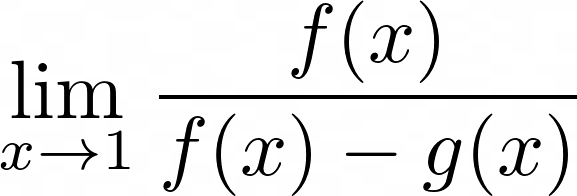
To simplify this, we’d want to use the product law, the quotient law, and another limit law called the difference law. Our original expression becomes

So we have 3/(3-2) = 3.
Limit of Functions: References
Clark, P. L. “Convergence.” 2014. http://math.uga.edu/~pete/convergence.pdf.
Desmos graphing calculator (graph images).
Gunnells, Paul. Math 131 Calculus I Handout 2.3. Retrieved from http://people.math.umass.edu/~gunnells/teaching/Sample_Lecture_Notes.pdf on September 8, 2019
Hight, D. W. A Concept of Limits. New York: Prentice-Hall, 1966.
Klinger-Logan, Kim. Calculus Lecture Notes, Chapter 2. Limits. Retrieved from http://www-users.math.umn.edu/~kling202/hamline/calculus/Chapter2/Limits on September 8, 2019
Libretexts. Calculus Map: Calculus– Early Transcendental (Stewart). Retrieved from https://math.libretexts.org/Bookshelves/Calculus/Map%3A_Calculus_-_Early_Transcendentals_(Stewart)/2%3A_Limits_and_Derivatives/2.3%3A_Calculating_Limits_Using_the_Limit_Laws on September 8, 2019
